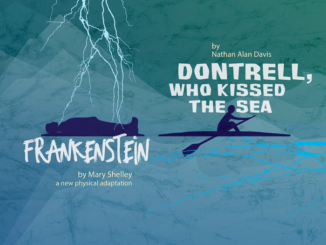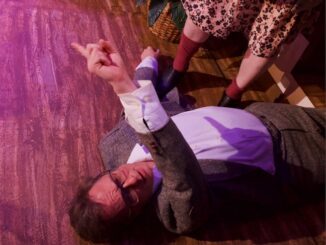
In 1952, Charles Chaplin asked Buster Keaton to play a minor role in a movie in which Chaplin was the writer, director, and star. That semi autobiographical film was called “Limelight.” This play, by Greg Lam, envisions what might have happened on the set of the movie, the only one in which the two comic geniuses worked together. It is not a re-creation of the Silent Film era, though it certainly showcases its brilliance. For me, the heart and soul of this play was beautifully verbalized in one line Buster Keaton says to Charlie Chaplin about halfway through the production. He tells Chaplin that people in every country in the world can mimic his routines as the Tramp. They all know how to walk like him with baggy pants, hat and cane. BUT, NO person is going to memorize his monologues and speeches that are politically and morally motivated. The entire play is built around that conflict in the views of these two legendary comedians, both of whom had fallen out of grace in America. Charlie Chaplin felt strongly that a comedian had a duty to use his fame and his talents to help make the world a better place, as he saw it. Buster Keaton thought the role of the comedian was to entertain and to provide people with an escape from the issues confronting them.

The two actors who portrayed Chaplin and Keaton must have studied every aspect of these comedians’ lives. The mannerisms and emotions seemed genuine. David Scott embodied Chaplin in every way. His need for acceptance of his political views and comedic decisions was plain to see. His interactions with the women in his life were predictable, and realistic. David Boyll paid tribute to Buster Keaton with his staunch beliefs in his role as a citizen of the United States and as an entertainer. Boyll was very believable as Keaton when his attempts to convince Chaplin to be satisfied with his life as an entertainer were tempered by his own obvious pain at having fallen so far from his glory days of fame in the silent film industry. David Scott and David Boyll both have the acting skills required to shine in the roles of the iconic silent film stars.

Two very clever tactics are employed throughout the play to add to the entertainment and remind the audience of just how great silent films were. The first tactic was the use of a giant screen that remained in the back of the stage with parts of silent films running at appropriate times. Though this play is two hours long, I suggest you arrive very early. Prior to the start of the play, Chaplin and Keaton films are continuously running on the screen on stage. I was laughing so much at these short films that it didn’t matter if the play started on time. Once the play did start the screen is used to announce scene changes and such in the same way it was done in silent films. The second clever tactic was the flashbacks to skits that Chaplin and Keaton made famous in their heyday. The younger Chaplin, as The Tramp, and Keaton, as Stoneface, were on stage re-creating these scenes at the same time the older versions of the stars were discussing their roles in “Limelight.” The silent re-enactments were very funny, and often employed the ubiquitous “girl” for the two comedians to try to win over.


Johnny Villar had a very tough role, because he played The Tramp, and most likely everyone in the audience knew how that character would move and react in each skit. Kudos to the costume designer and to Mr. Villar because he was a very believable Tramp. The casting was excellent in this role, as was the acting. Anthony Castillon was cast as Stoneface, the nickname for the young Buster Keaton because of his lack of expression in his silent films. Castillon re-created some of the physical comedy Keaton made famous. These two were greatly aided in the comedic timing by Skylar Rose Adams, who played “the girl” in the skits.

Since this play is about a movie filmed in 1952, it was disturbingly realistic to watch Lorie Goulart play the role of the ever-subservient script girl, Beverly, basically the assistant (to get coffee and such) for the stars of the movie. Goulart’s portrayal was so believable. It was obvious she wanted to please the stars and to keep her job by doing whatever was asked of her. It was great to watch her gain confidence and the respect of Buster Keaton as the play progressed. Likewise, Selin Sahbazoglu, cast as both Chaplin’s wife, Oona, and his costar, Claire Bloom, displayed confidence in her roles in the life of Chaplin. But she did so in a way that preserved and fed his ego. Portraying actresses in the 1950’s is challenging, but these two women were more than up to the challenge.

Many people say that life is harder today than it used to be. We complain about the political climate, the corporate influencers, the economy, and even Hollywood. After seeing this play, I think if I asked Charlie Chaplin and Buster Keaton whether these things were a lot better in 1952, they would answer with a resounding “NO.” While the play is set in a bygone era, the issues are as relevant today as they were then. Do entertainers have the duty or even the right to use their fame to share the views they think will make the world a better place, or is their role solely to entertain? This play may change your mind about that dilemma. It will certainly make you think as you are laughing.
This play is a world premier you can see right here in Mountain View. This is more proof that The Pear Theatre brings unique and amazing productions to the Bay Area. It is located at 1110 La Avenida, Suite A, an intimate setting. See their website, thepear.org to get tickets and read more about the play. It runs now through July 21st, so this is your opportunity to be one of the first patrons of the arts to see this play.




Be the first to comment